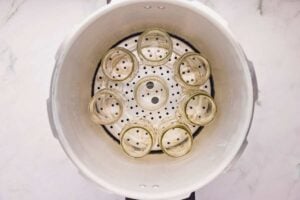How to Can Butternut Squash Soup (Step-by-Step)
This butternut squash soup canning recipe helps you prepare ready-to-go soup that lasts all year. This pressure canning recipe only preserves the squash in cubes (following the USDA’s guidelines). When you’re ready to eat, open the jar, heat it, and blend! Always give your jars the correct headspace to create a safe and effective seal.
Butternut Squash Soup Canning Recipe

Equipment
- Mason jars
Ingredients
- 6 cups butternut squash peeled, cored, and cut into 1-inch cubes (about 1 medium)
- 6 cups Yukon gold potatoes peeled and cubed
- 1 cup carrots peeled and chopped
- 1 medium onion chopped
- 6 cloves garlic finely chopped
- Canning salt
Save This Recipe
You'll join my email list which you will love. And if you don't, unsubscribe in one click. ❤️
Instructions
- Prep jars. Wash your jars with hot, soapy water and place them in the pressure canner. Fill the canner with about three inches of water. Fill the jars halfway with water so they stay anchored to the bottom of the canner. Place the lid on without locking it and set the heat to medium. Place your rings and lids into a saucepan with water, place over low heat, and bring to a simmer.

- Cook squash and potatoes. Bring a large pot of water to a boil. Place the peeled and cubed butternut squash and potatoes in the pot to cook for 3 minutes.

- Add rest of veggies. Next, add the carrots, onions, and garlic. Stir to combine.

- Scrap film off. As the veggies cook, scrap off the yellow film that gathers on the top.

- Fill jars. Remove the jars from the pressure canner and place the canning funnel on one of the jars. Using a ladle, ladle the hot soup base into the hot jars leaving 1 inch headspace. Repeat this process until all the jars have been filled.

- Add canning salt. Top each jar with ½ teaspoon of canning salt for pints, or 1 teaspoon of canning salt for quarts.

- Debubble and wipe rims. Using a debubbler, remove any bubbles that may be in the jars. Top off with hot water maintaining a 1-inch headspace. Wipe the rims with a damp towel.

- Prepare for canning. Place the rims and rings on top of the jars. Tighten the rings so they are fingertip-tight. Transfer the jars to the pressure canner. Adjust the water so there is enough water as per your pressure canner manufacturer's recommendations. Add a splash of white vinegar to the canner to prevent cloudy jars. Secure the lid to the pressure canner and place over medium heat.

- Process. Once the canner is venting steam consistently set the timer for 10 minutes. After 10 minutes, add 10 pounds of weight to your weighted canner or set the dial to 10 pounds for a dial canner, adjusting for altitude as needed. Once the canner comes to pressure, set a timer for 75 minutes for pint jars or 90 minutes for quarts. Make sure your canner maintains its pressure for the full time. If your canner goes below its desired pressure, stop the timer, bring the canner back up to pressure then start your timer again.
- Cool. Once the timer goes off, remove the canner from the heat and allow the canner to reduce its pressure naturally. Once it reads 0 pounds of pressure, remove the weight or adjust the dial to 0 and allow more steam to vent. Once the steam has fully vented, wait 10 more minutes. Remove the lid, tilting it away from your face, and allow the jars to sit for 5 minutes. Transfer the jars to a heat-safe area and allow them to cool for 12-24 hours.

- Check seals and store. After 24 hours, check for a proper seal by pressing the center of the lid. If it is down and doesn’t pop back up, it is good. If it pops back up, refrigerate and use within 3 days. Once a proper seal has been confirmed, remove the rings and store the jars in a cool dark place for 12-18 months or per your lid manufacturer’s recommendations.
- Make soup when ready. This is only a soup base. The USDA only recommends preserving winter squash as cubes (not a full blended soup). To make the soup, add the contents of the jar into a saucepan and bring to a boil. Once boiling, reduce to a simmer. Using an immersion blender, blend until smooth (you can also transfer this to your blender and blend for 30-45 seconds). Take a taste test and add salt and pepper as needed. You can top it with some heavy cream and herbs! This soup goes really well with some crusty bread.

Nutrition
There is only so much butternut squash one can eat fresh. But having jars of this soup base is handy and delicious, besides being a great way to save your harvest. Pair it with some bread machine French bread or grilled cheese for a simple homemade lunch or dinner.

Key Ingredients and Tools
Pressure Canner. Canning low-acid foods like butternut squash soup require a pressure canner to reach temperatures high enough to destroy harmful bacteria. You can also make pressure canned beef stew to have another delicious soup in your pantry ready to go.
A Newsletter you’ll love
Daily recipes from the farmhouse, Sunday meal plans, seasonal ideas, straight from my kitchen to your inbox.
I promise to keep your email address safe. Unsubscribe at any time
Canning Salt. This special salt is formulated without additives that can cloud your jars or interfere with the canning process.

Butternut Squash. Look for a squash that feels heavy for its size and has a hard, smooth rind with no soft spots or bruises. The color should be a deep, even beige. Feel free to experiment with other winter squashes like acorn squash or kabocha squash.
Yukon Gold Potatoes. These potatoes have a naturally buttery flavor and creamy texture that complements the sweetness of the butternut squash. They also hold their shape well during canning.
Why You Need to Pressure Can
Butternut squash is a low-acid food, and water bath canning is insufficient to destroy harmful bacteria that can thrive in low-acid environments. Using a pressure canner is essential for safety.
Along these same lines, pumpkins and other winter squashes need to be pressure canned.
Pay Attention to the Dial Gauge
If you notice the pressure dropping, check the heat source to make sure it’s still at the correct temperature. You may also need to adjust the weight or dial on your canner. If the pressure continues to drop, it’s best to stop the timer, bring the canner back up to pressure, and then restart the timer for the remaining processing time.
What To Do If Your Jars Don’t Seal During Pressure Canning
It happens sometimes. There could be a few reasons why your jars didn’t seal:
- Improper headspace: Make sure you leave the correct amount of headspace (1 inch) in the jars.
- Dirty rims: Even a tiny bit of food residue on the jar rims can prevent a proper seal. Wipe them carefully with a clean, damp cloth before placing the lids.
- Old or damaged lids: Lids can lose their sealing ability over time or become damaged. Always use new lids for canning.
I hope you enjoy this soup canning recipe. It’s delicious, convenient, and homemade. Perfect for any from scratch farmhouse kitchen. Having ready-to-go soups in your pantry will save you time and money.

Love,





















